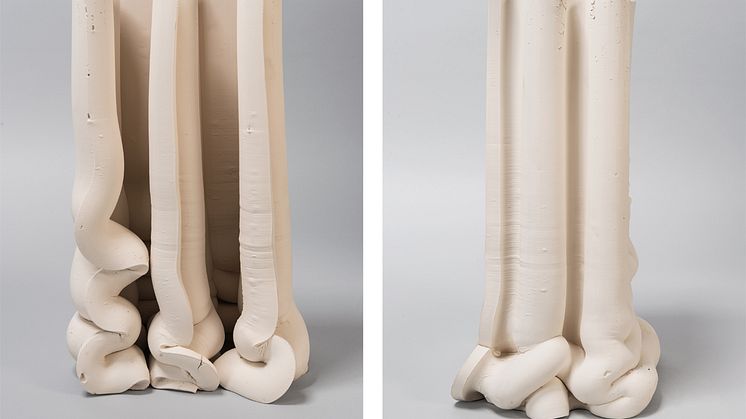
Press release -
Nationalmuseum acquires Anton Alvarez sculpture
Nationalmuseum has added the ceramic sculpture Alphabet Aerobics E–16 by Anton Alvarez to its collection. Alvarez’s art is an ongoing study of how he can create artefacts while liberating himself from mass manufacturing and the expectations and traditions of the world at large.
Alvarez graduated in 2012 with a master’s degree from the Royal College of Art in London. In the course of his studies he had developed a design technique and a purpose-built Thread Wrapping Machine, with which he created furniture by wrapping threads around pieces of wood and plastic. These one-of-a-kind furniture pieces were designed on the go as they took shape. In 2015 the Friends of Nationalmuseum Bengt Julin Memorial Fund generously donated to the museum an Alvarez chair in this technique (NMK 36/2015). One year later the museum received a further gift from the fund in the form of a ceramic sculpture by Alvarez named E–16, part of his Alphabet Aerobics series.
Alvarez creates the Alphabet Aerobics pieces using a machine called The Extruder, developed in partnership with Jakob Öhman, a computer programmer. The machine is a large-scale clay press that applies three tonnes of pressure to extrude the clay via various moulds shaped like letters of the alphabet. E–16, extruded through the E mould, is one of the first sculptures made by Alvarez in the machine.
Alvarez believes that, as a designer, he has the privilege of being able not only to shape objects, products, spaces and architecture but also to design his own reality and create the context he wishes to operate in. He has therefore assumed the mantle of constructor. The Extruder is more powerful and offers a faster production method than the Thread Wrapping Machine, while releasing Alvarez from the key role in the creation process. His intention was to “design himself out of the process”, a goal he believes he has achieved.
In 2016 Alvarez displayed The Extruder at the National Centre for Craft and Design in Sleaford , England, where he let the exhibition attendants get involved in the creation process. For the three-month duration of the exhibition, staff were able to “produce” pieces for display. Clay was extruded using the machine and then fired and put on show. All this happened under the gaze of visitors but without the artist being present.
Alvarez’s project and artistic process address issues such as the autonomous role of the artist and production conditions (an opportune issue at a time when sustainability and social justice are high on the agenda). There is also a solidarity aspect that recalls 1970s demands for “everyone”, not just the artist, to be involved in the creative process.
The acquisition of E–16 illustrates the ongoing blurring of the boundaries between art and fine craft. The sculpture was exhibited at and acquired from the autumn 2016 exhibition The Death of Ceramics at hangmenProjects in Stockholm, which was widely covered by the media and focused on the interface between art and craft in the ceramic field.
Details
Anton Alvarez, Alphabet Aerobics E–16, 2016
Raw-fired clay
Gift from Nationalmusei Vänner Bengt Julins fond
Inventory number
NMK 395/2016
For more information contact
Cilla Robach, senior curator: +46 8 5195 4305, cilla.robach@nationalmuseum.se
Mattias Robertson, press officer: +46 767 234632, press@nationalmuseum.se
Categories
Nationalmuseum is Sweden’s premier museum of art and design. The collections comprise older paintings, sculpture, drawings and graphic art, and applied art and design up to the present day. The museum building is currently under renovation and scheduled to open again in 2018. In the meantime, the museum will continue its activities through collaborations both in Sweden and abroad as well as temporary exhibitions at Nationalmuseum Design at Kulturhuset Stadsteatern in Stockholm. Nationalmuseum has partnerships with Svenska Dagbladet and the Grand Hôtel Stockholm.

